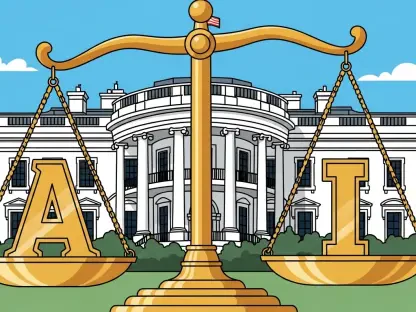In the rapidly evolving landscape of artificial intelligence, Australia finds itself at a critical juncture where the balance between technological advancement and the protection of intellectual property hangs in a delicate equilibrium, prompting intense debate. A recent interim report from the Productivity Commission has ignited a fierce discussion by suggesting that loosening data protection laws could unlock significant economic potential through enhanced AI development. Proponents argue that such reforms could contribute billions to the national economy by facilitating data mining for training AI models. Yet, this proposal has met with staunch opposition from media and creative industries, who fear that relaxing these regulations might jeopardize cultural heritage and creators’ rights. As the nation grapples with these competing priorities, the question arises whether easing data laws is a necessary step for innovation or a risky move that could undermine Australia’s creative and economic sovereignty. This discussion demands a closer examination of both perspectives to understand the broader implications.
Economic Promises vs. Privacy Concerns
The Productivity Commission’s interim report, titled Harnessing Data and Digital Technology, presents a compelling case for relaxing data protection laws under the Privacy Act. It argues that current restrictions create unnecessary barriers to innovation, preventing the full potential of AI technologies from being realized. By adopting a more flexible data-sharing framework, the report estimates that Australia could see an economic boost of up to $10 billion annually. This figure underscores the transformative power of AI in driving efficiency and growth across various sectors, from healthcare to agriculture. Supporters of this view believe that enabling tech companies to access broader datasets for AI training could position Australia as a global leader in digital innovation, attracting investment and fostering cutting-edge research. However, the promise of economic gain comes with significant caveats, as privacy advocates warn that such changes might expose personal information to misuse, raising ethical questions about the cost of progress.
On the other hand, the proposed relaxation of data laws has sparked alarm among privacy and security experts who argue that the risks far outweigh the potential benefits. The existing Privacy Act, while restrictive in some respects, provides a crucial safeguard against unauthorized data exploitation, protecting individuals from breaches that could have far-reaching consequences. Critics point out that loosening these regulations could erode public trust in digital systems, especially if sensitive information is mishandled by AI companies with little accountability. Furthermore, the economic projections cited in the report are viewed with skepticism by some, who question whether the promised billions will materialize or simply benefit a handful of large tech firms. This perspective emphasizes the need for a cautious approach, suggesting that innovation should not come at the expense of fundamental rights. Instead, there is a call for alternative strategies that enhance AI development without compromising the robust protections currently in place, ensuring a balanced path forward.
Cultural Sovereignty and Intellectual Property Risks
A significant point of contention in this debate centers on the potential threat to Australia’s cultural sovereignty and intellectual property rights if data laws are relaxed. Leaders in the media and creative sectors have voiced strong opposition, arguing that current copyright and privacy laws strike an appropriate balance between innovation and protection. They contend that Australian creative works—spanning music, literature, and art—represent national treasures that must be shielded from exploitation by AI companies seeking to mine data without fair compensation. Prominent figures in the industry have highlighted how existing frameworks already facilitate licensing agreements that respect creators’ rights while allowing controlled use of their content. The fear is that easing restrictions would enable unchecked access to these works, diluting their value and undermining the livelihoods of local artists and writers who contribute significantly to the economy, with their industries generating over $60 billion annually.
Beyond the economic impact, there is a deeper concern about the loss of control over Australia’s intellectual assets and the broader implications for cultural identity. Critics warn that relaxing data laws could disproportionately favor foreign tech giants, allowing them to profit from Australian content while offering little in return to the local community. This sentiment is echoed by voices in the creative sector who question why regulations should be altered to benefit overseas corporations at the expense of domestic talent. There is a palpable fear that such a move could erode the unique cultural narrative that defines the nation, as algorithms trained on local data might repurpose content in ways that distort its original intent. This perspective calls for maintaining or even strengthening current laws to ensure that the benefits of AI innovation are equitably shared, preserving the integrity of Australia’s creative heritage while still engaging with technological advancements on fair terms.
Voices of Opposition and Calls for Stronger Regulation
The opposition to the Productivity Commission’s recommendations has been both vocal and unified across various sectors, with media executives and union leaders presenting a cohesive front against deregulation. High-profile industry figures argue that Australia’s copyright laws are not only adequate but also essential in the AI era, providing a structure for fair negotiation and compensation. They challenge the notion that these laws stifle innovation, asserting instead that they protect against exploitation by ensuring creators retain control over their intellectual property. The critique often targets the perceived agenda of big tech companies, with questions raised about why these entities should access Australian content freely while safeguarding their own proprietary algorithms. This disparity fuels a broader narrative of fairness and reciprocity, emphasizing that any regulatory changes must prioritize national interests over corporate gains, maintaining a level playing field.
Adding to the chorus of dissent, unions and former policymakers have advocated for a more stringent approach, proposing the development of a dedicated Artificial Intelligence Act to safeguard jobs and creative rights. This stance contrasts sharply with the Productivity Commission’s push for deregulation, highlighting a fundamental divide between economic ambitions and cultural preservation. The call for tougher legislation reflects a belief that existing laws, while effective, may need reinforcement to address the unique challenges posed by AI technologies. Concerns about job displacement and the potential for widespread data misuse—described by some as akin to theft—underpin this push for enhanced protections. Stakeholders argue that without robust regulations, the rapid integration of AI could destabilize local industries, leaving workers and creators vulnerable. This perspective underscores the urgency of crafting policies that balance technological progress with the need to protect Australia’s economic and cultural fabric, ensuring long-term stability.
Balancing Innovation with Protection
Reflecting on the polarized debate, it becomes evident that the clash between economic innovation and the safeguarding of intellectual property has reached a critical impasse. The Productivity Commission’s vision of relaxed data laws as a catalyst for growth was met with resolute opposition from those who saw it as a direct threat to creators and cultural heritage. Media and creative sectors stood firm, insisting that Australia’s existing copyright and privacy frameworks have proven effective in balancing innovation with protection. Their unified resistance underscored a shared conviction that the risks of deregulation—ranging from loss of cultural sovereignty to economic inequity—far outweigh the speculative benefits touted by proponents of change. The discourse revealed a profound skepticism toward the idea that big tech would equitably share the gains of AI advancements, leaving a lasting impression of the need for fairness.
Looking ahead, the path forward demands a nuanced approach that bridges the gap between these opposing views. Policymakers must consider hybrid solutions, such as optimizing current licensing frameworks to support AI development while introducing targeted guidelines to prevent misuse of data. Exploring international models of AI regulation could offer valuable insights, ensuring that Australia remains competitive without sacrificing its creative and intellectual assets. Additionally, fostering dialogue between tech innovators and cultural stakeholders might pave the way for collaborative frameworks that align economic goals with ethical standards. As this debate continues to unfold, the focus should remain on crafting policies that protect national interests while embracing the transformative potential of AI, ensuring that innovation serves as a tool for collective progress rather than a source of division.









